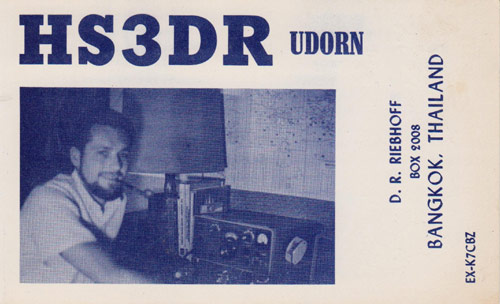

HS3DR 1968 Thailand
Don Riebhoff K7ZZ (K7CBZ) was also an op at XU1DX, 1S1A Spratly, TI9CF Cocos, XW8CS, CT4AT, and 3W8D Vietnam.
At the time of the issuance of the
HS3DR call sign to Don Riebhoff Thailand was indeed on the
USA/ITU banned list. But the call sign was issued by Thai Police
Lieutenant Chankij Boonyaratvej, HS1CB, President of STAR
(Society of Thai Amateur Radio), as was my HS3AL call sign. We
got a membership card in STAR indicating our call sign, which
served as our "license". At that time the call signs
were determined as follows: HS (Thailand); 3 (Thai Third Army
District); DR (Don's Initials). With a number of US hams
stationed on military bases all around Thailand in connection
with the war in Viet Nam, some of them figured out how the calls
were determined and went on the air with "self
assigned" calls without going through STAR. Therefore
effective January 1, 1970, STAR changed to a new system of
determining call signs. While Thai nationals continued to have
two-letter suffixes, non-Thais from that point on were issued
three-letter suffixes by STAR in strict alphabetical order.
Because HS1AA was a prominent Thai ham in the government's
Ministry of Education, the call signs for non-Thais began with
HS1AB_ in order that there wouldn't be any confusion between the
new calls and him. At the December 1969 monthly meeting of STAR
at the Monthien Hotel in Bangkok, existing non-Thai members of
RAST drew suffixes out of a hat as it was passed around, and I
came up with "ABD". Don got "ABM'". At the
same time, the way the call areas was determined changed from
Army Districts to Police Districts. This was very amenable to
Chankij who after all was with the Thai police. It also expanded
the number of prefixes available since the Thai police had nine
districts. Don was operating from the fourth police district so
he ended up with HS4ABM. I was operating from the fifth police
district so I ended up as HS5ABD. The police districts also
correspond with Thailand's postal districts, so when the Thai
Posts and Telegraphs Department formally legalized Amateur Radio
in 1987, the call areas stayed the same as STAR had determined in
1970. The zero prefix, which was reserved for club stations under
STAR, became an overflow prefix for the first call area -- the
area which includes Bangkok -- when Amateur Radio was legalized.
It is little realized but Thailand has had tremendous growth of
the Amateur Radio Service since 1987 but almost all Thai hams are
limited to channelized operation on two meter FM only. After
almost nine years without upgrade exams being available to Thai
hams which would allow them to move up to HF operations, an exam
was recently held in Bangkok and 42 Thai nationals upgraded to HF
status. More such exams will be held now that the ice has broken.
According to Champ, E21EIC, on May 4, 2012, the NBTC (Thailand's
FCC) reported that there were 246,959 Thai hams licensed for VHF
operations, while only 717 Thai hams were licensed for HF
operations. The growth in the Thai amateur ranks meant that, even
after Thailand got the E2 prefix from ITU to add to the HS prefix
they already had, there was quickly an overflow in the Bangkok
region once again. So now it is no longer possible to tell from
the call sign of a Thai ham alone, where he is operating from.
But by noting the first number of the five-character zip code in
his address you can tell which of the traditional call areas he
is in. Non-Thai hams are issued HS0Z__ calls with two additional
letters. The system is based on the Brazilian custom of issuing
three-letter suffixes beginning with "Z" to foreigners,
because John Vajo, W2ZWW, who worked out the system of reciprocal
agreements with the Thai authorities, had lived in Brazil before
he moved to Thailand. Logically enough John is HS0ZAA. The HS0Z
calls are approximately up to HS0ZLA at this time (August 2012).
FWIW, according to Champ, as of July 2, 2012 the most recent call
signs issued by NBTC in each traditional call area were as
follows:
call area 1 E23PIJ
call area 2 E27HXQ
call area 3 HS3YVE
call area 4 HS4YRT
call area 5 E22ZXC
call area 6 E23IEG
call area 7 E29FIX
call area 8 E24AGF
call area 9 E23BVQ
In about October or November 1969, thanks to our close
coordination with Dick Baldwin, W1RU of ARRL, the FCC lifted the
ban on communication with Thai hams. (It should be noted that
Dick went on to become the President of IARU and recently passed
away (June 21, 2012) at the age of 92. The Amateur Radio Service
owes a debt of gratitude to Dick, who was a very popular IARU
President because he visited every single IARU member society in
the world during his term in office -- except Cuba because the
USG wouldn't permit him to go there. Few people if any have done
more to improve the world-wide status of ham radio than Dick. He
is one of my all-time heroes.
QSL G4UZN Collection
Info courtesy of K3ZO